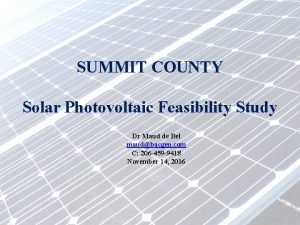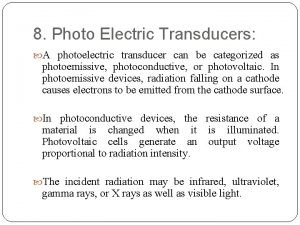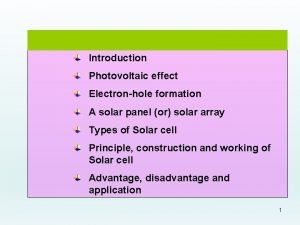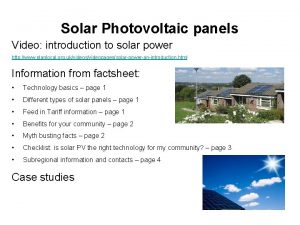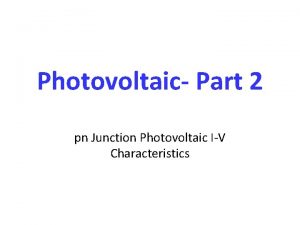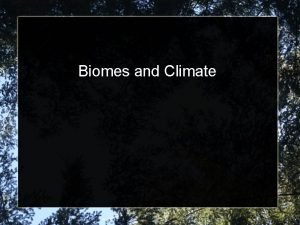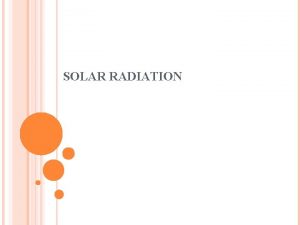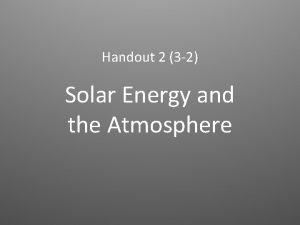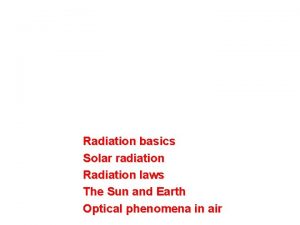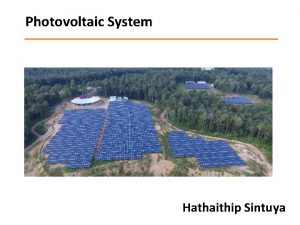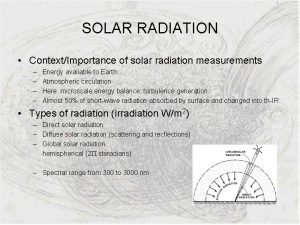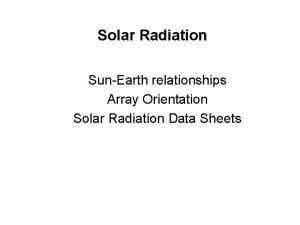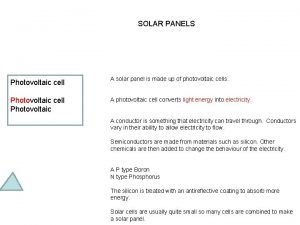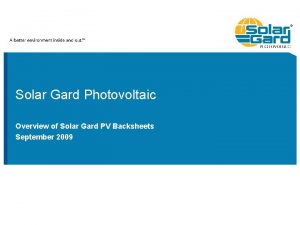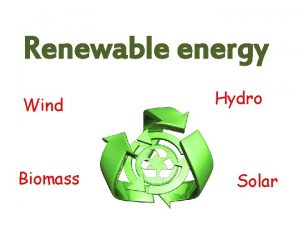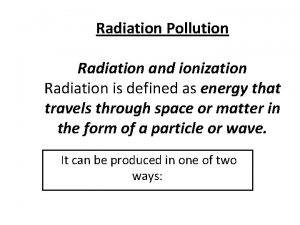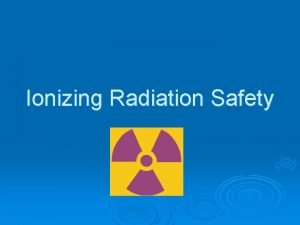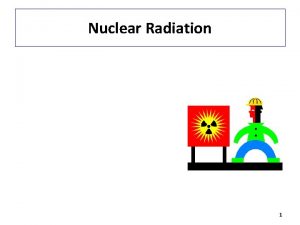A solar radiation model for photovoltaic and solar

































- Slides: 33

A solar radiation model for photovoltaic and solar thermal power exploitation F. Díaz, G. Montero, J. M. Escobar, E. Rodríguez, R. Montenegro

Contents 1. Introduction 2. Terrain surface mesh and detection of shadows 3. Solar radiation modelling -Solar radiation equations for clear sky Beam radiation Diffuse radiation Reflected radiation -Solar radiation for real sky -Typical meteorological year (TMY) 4. Results 5. Conclusions

Introduction • Solar power is one of the most appreciate renewable energies in the world • Three groups of factors determine the interaction of solar radiation with the earth’s atmosphere and surface a. Earth’s geometry, revolution and rotation (declination, latitude, solar hour angle) b. Terrain (elevation, albedo, surface inclination/orientation, shadows) c. Atmospheric attenuation (scattering, absorption) by c. 1. Gases (air molecules, ozone, CO 2 and O 2) c. 2. Solid and liquid particles (aerosols, including non-condensed water) c. 3. Clouds (condensed water) • Correct estimation needs an accurate definition of the terrain surface and the produced shadows. Previous works. • A typical meteorological year (TMY) for each available measurement stations has been developed.

Introduction Topography Shadows Albedo • Beam Radiation • Diffuse Radiation • Reflected Radiation • Global Radiation Clear Sky Experimental Data Real sky

Terrain surface mesh and shadows • Build a sequence of nested meshes from a regular triangulation of the rectangular region, such that the level j is obtained by a global refinement of the previous level j− 1 with the 4 -T Rivara’s algorithm • The number of levels m of the sequence is determined by the degree of discretization of the terrain, • Define a new sequence until level m’ ≤ m applying a derefinement algorithm Two derefinement parameters εh and εa are introduced and they determine the accuracy of the approximation to terrain surface and albedo, respectively.

Terrain surface mesh and shadows Day angle Sun declination Solar altitude and Solar azimuth Solar beam direction Hour angle

Terrain surface mesh and shadows Construct a reference system x’, y’ and z’, with z’ in the direction of the beam radiation, and the mesh is projected on the plane x’y’ The incidence solar angle δexp is then computed for each triangle Check for each triangle Δ of the mesh, if there exists another Δ’ that intersects Δ and is in front of it, i. e. , the z’ coordinates of the intersection points with Δ’ are greater than those of Δ.

Terrain surface mesh and shadows 12: 00 hours 14: 00 hours 12: 00 hours 16: 00 hours 18: 00 hurs

Solar radiation modelling General aspects: Use of solar adaptive meshes for surface andŠúri a new This radiation model is baseddiscretization onflow: the work of and method Hofierkafor Calculations detecting the shadows over each triangle of the surface. 1. We first calculate the solar radiation under the assumption of clear sky for all the triangles of the mesh. 2. Typical Meteorological Year (TMY) is evaluated for all the involved measurement stations. 3. Solar radiation values are corrected for a real sky by using the TMY from the available data of the measurement stations in each time step along an episode. Steps 1 and 3 are repeated for each time step and finally, the total solar radiation is obtained integrating all the instantaneous values in each triangle.

Solar radiation modelling Solar radiation equations for clear sky Solar radiation types Beam Diffuse Reflected

Solar radiation modelling Solar radiation equations for clear sky Solar constant Beam radiation Extraterrestrial irradiance G 0 normal to the solar beam Correction factor Linke atmospheric turbidity factor Beam irradiance normal to the solar beam Gb 0 c = G 0 exp{− 0. 8662 TLKmδR(m)} Beam irradiance on a horizontal surface Gbc(0) = Gb 0 c Lf sin h 0 Relative optical air mass h 0: the solar altitude angle Lf: the lighting factor Beam irradiance on an inclined surface Gbc(b) = Gb 0 c. Lf sin δexp: the incidence solar angle

Solar radiation modelling Solar radiation equations for clear sky Diffuse radiation Diffuse transmission Diffuse radiation on horizontal surfaces Diffuse radiation on inclined surfaces ho ≥ 0. 1 Sunlit surfaces ho < 0. 1 Shadowed surfaces Function depending on the solar altitude

Solar radiation modelling Solar radiation equations for clear sky Reflected radiation Mean ground albedo

Solar radiation modelling Solar radiation under real-sky Values of global irradiation on a horizontal surface for real sky conditions G(0) are calculated as a correction of those of clear sky Gc(0) with the clear sky index kc If some measures of global radiation Gs(0) are available at different measurement stations, the value of the clear sky index at those points may be computed as Then kc may be interpolated in the whole studied zone

Solar radiation modelling Typical meteorological year (TMY) To obtain accurate real sky values of global irradiation, the evaluation of a TMY is needed to avoid results based on a particular year weather conditions We compute the daily typical meteorological year of maximums, means, medians, variance and percentiles of 90% and 75% series of values using weight means to smooth the irregular data. TMY series were fitted to third grade Fourier series

Solar radiation modelling Typical meteorological year (TMY) Means Medians

Results The studied case corresponds to Gran Canaria, one of the Canary Islands in the Atlantic Ocean at 28. 06 latitude and − 15. 25 longitude. The UTM coordinates (metres) that define the corners of the considered rectangular domain including the island are (417025, 3061825) and (466475, 3117475), respectively. TMY (1998 – 2008) for all the stations in Gran Canaria Island were obtained for every month. The average global radiation (real sky), varies from: • 10. 6 MJ/m 2 per day in December • 25. 6 MJ/m 2 per day in June

Results Geolocation of different stations on Gran Canaria Island Elevation map of Gran Canaria

Results Macaronesic laurisilva 0. 05 Salt mine 0. 6 Albedo map of Gran Canaria

Results Intermediate mesh 5866 nodes 11683 triangles Triangular mesh adapted to topography and albedo

Results EXAMPLE 82 − 87% of the mean global irradiation Beam radiation map (J/m 2) December 2006

Results EXAMPLE 13 − 18% of the mean global irradiation Diffuse radiation map (J/m 2) December 2006

Results EXAMPLE 0 − 0. 5% of the mean global irradiation Reflected radiation map (J/m 2) December 2006

Results Clear sky global radiation map (J/m 2) December 2006 Real sky global radiation map (J/m 2) December 2006

Results Annual evolution of the computed monthly average per day (TMY) for both, clear sky and real sky global radiation 35 30 DE (MJ/m 2) 25 DE 20 Real sky 15 Clear sky 10 Trend (Real sky) 5 Trend (Clear sky) 0 1 3 5 7 Months 9 11

Results Percentage decrease from the computed radiation: Real sky to clear sky 30. 00% 25. 00% 20. 00% TRADE WINDS 15. 00% 10. 00% Decrement RS to CS 5. 00% Trend 0. 00% 1 3 5 7 Months 9 11

Results Influence of the trade winds: Annual Wind Rose for Canary Islands Frequency (%)

Results Influence of the trade winds:

Results SIMULATIONS: Monthly average Real Sky radiation January April

Results SIMULATIONS: Monthly average Real Sky radiation July October

Results Solar Power Generation: Photovoltaic and Solar Thermal Hourly Clear Sky radiation calculation for all days Clear Sky Irradiance Numerical Integration Real Sky Irradiance Clear Sky Index and Interpolation Solar PV Model Solar Thermal Model Irradiation and Energy for Real Sky conditions Electric Power Generation

Conclusions • The adaptive triangulation related to the topography and albedo is essential in order to obtain accurate results of shadow distribution and solar radiation • Adaptive meshes lead to a minimum computational cost, since the number of triangles to be used is optimum. • Statistical treatment of data is necessary to reach accurate conclusions about the possible behaviour of the radiation distribution values • Typical meteorological year (TMY) is the departure point to estimate the real sky radiation values • The model allows to choose the most suitable zone in the island for a solar power station • Rectangular collectors can be included in the model as composed by two triangles in the same plane

A solar radiation model for photovoltaic and solar thermal power exploitation F. Díaz, G. Montero, J. M. Escobar, E. Rodríguez, R. Montenegro
 Wholesale solar controller
Wholesale solar controller Solar summit county
Solar summit county Photoelectric transducers
Photoelectric transducers Photovoltaic effects
Photovoltaic effects Photovoltaic video
Photovoltaic video Photovoltaic
Photovoltaic Photovoltaic array maximum power point tracking array
Photovoltaic array maximum power point tracking array Solar radiation has a part in the water cycle by
Solar radiation has a part in the water cycle by National solar radiation database
National solar radiation database What receives the most solar radiation
What receives the most solar radiation Solar radiation
Solar radiation Solar radiation
Solar radiation Inexhaustible source of energy
Inexhaustible source of energy Viscous heating fluent
Viscous heating fluent Kontinuitetshantering
Kontinuitetshantering Novell typiska drag
Novell typiska drag Tack för att ni lyssnade bild
Tack för att ni lyssnade bild Vad står k.r.å.k.a.n för
Vad står k.r.å.k.a.n för Varför kallas perioden 1918-1939 för mellankrigstiden
Varför kallas perioden 1918-1939 för mellankrigstiden En lathund för arbete med kontinuitetshantering
En lathund för arbete med kontinuitetshantering Underlag för särskild löneskatt på pensionskostnader
Underlag för särskild löneskatt på pensionskostnader Tidbok
Tidbok Sura för anatom
Sura för anatom Förklara densitet för barn
Förklara densitet för barn Datorkunskap för nybörjare
Datorkunskap för nybörjare Stig kerman
Stig kerman Mall för debattartikel
Mall för debattartikel Delegerande ledarstil
Delegerande ledarstil Nyckelkompetenser för livslångt lärande
Nyckelkompetenser för livslångt lärande Påbyggnader för flakfordon
Påbyggnader för flakfordon Arkimedes princip formel
Arkimedes princip formel Svenskt ramverk för digital samverkan
Svenskt ramverk för digital samverkan I gullregnens månad
I gullregnens månad Presentera för publik crossboss
Presentera för publik crossboss

